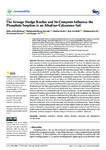The Sewage Sludge Biochar and Its Composts Influence the Phosphate Sorption in an Alkaline–Calcareous Soil
| dc.contributor.author | Rehman, RA | en |
| dc.contributor.author | Qayyum, MF | en |
| dc.contributor.author | Haider, G | en |
| dc.contributor.author | Schofield, K | en |
| dc.contributor.author | Abid, M | en |
| dc.contributor.author | Rizwan, M | en |
| dc.contributor.author | Ali, S | en |
| dc.date.accessioned | 2021-08-09T10:16:28Z | |
| dc.date.available | 2021-08-09T10:16:28Z | |
| dc.date.issued | 2021-02-07 | en |
| dc.identifier.issn | 2071-1050 | en |
| dc.identifier.uri | http://hdl.handle.net/10026.1/17424 | |
| dc.description.abstract |
<jats:p>This study evaluates the potential of sewage sludge, farm manure, rock phosphate, and their composts or biochar as useful materials for phosphorous (P) recovery. An alkaline–calcareous soil was incubated with different compost-based amendments to discern their impact on the P sorption characteristics. The treatments examined consisted of sewage sludge (SS), SS biochar (SS-BC), or composts of SS with rock phosphate (RP) and farm manure (FM) in different ratios, i.e., (i) control, (ii) SS, (iii) SS-BC, (iv) SS50:FM50, (v) SS75:FM25, (vi) SS25:FM25:RP50, (vii) SS50:FM25:RP25, (viii) SS75:FM0:RP25, and (ix) SS50:FM0:RP50. Prior to incubation for 45 days, the composts and biochar treatments combinations were characterized for elemental composition using Fourier transform infrared (FTIR) spectroscopy and X-ray diffraction (XRD) spectroscopy. The treated soils were analyzed for soil pH, electrical conductivity (EC), Olsen’s P, and P adsorption isotherms, at day 5 and 45 of the incubation. Langmuir and Freundlich’s equations were used to calculate P adsorption. Results showed that there was no significant influence on soil pH for any treatment throughout the experiment. However, soil EC decreased significantly for all treatments after 5 days of incubation; however, this effect was diminished after 45 days of incubation. All the treatments significantly decreased P sorption capacity both at the start (day 5) and end of the incubation (day 45) period compared to control. The treatment combination SS25:FM25:RP50 recovered the highest Olsen-P (79.41 mg kg−1). The other treatment combinations including SS and FM also recovered a greater Olsen’s P compared to the control. However, the sole application of only SS showed lower P recovery than the control soil, which further decreased with increase in incubation time. These findings improve our understanding that the stable pool of bioavailable P within an alkaline calcareous soil can be mobilized by using different organic treatment combinations instead of only SS. However, further in situ investigations may help to valorize the potential of sewage sludge, farm manure, rock phosphate, and their composts or biochar to improve P recovery in alkaline–calcareous.</jats:p> | en |
| dc.format.extent | 1779 - 1779 | en |
| dc.language | en | en |
| dc.language.iso | en | en |
| dc.publisher | MDPI | en |
| dc.title | The Sewage Sludge Biochar and Its Composts Influence the Phosphate Sorption in an Alkaline–Calcareous Soil | en |
| dc.type | Journal Article | |
| plymouth.issue | 4 | en |
| plymouth.volume | 13 | en |
| plymouth.journal | Sustainability | en |
| dc.identifier.doi | 10.3390/su13041779 | en |
| plymouth.organisational-group | /Plymouth | |
| plymouth.organisational-group | /Plymouth/Faculty of Science and Engineering | |
| plymouth.organisational-group | /Plymouth/Faculty of Science and Engineering/School of Geography, Earth and Environmental Sciences | |
| plymouth.organisational-group | /Plymouth/Users by role | |
| plymouth.organisational-group | /Plymouth/Users by role/Academics | |
| dcterms.dateAccepted | 2021-02-01 | en |
| dc.rights.embargodate | 2021-08-10 | en |
| dc.identifier.eissn | 2071-1050 | en |
| dc.rights.embargoperiod | Not known | en |
| rioxxterms.versionofrecord | 10.3390/su13041779 | en |
| rioxxterms.licenseref.uri | http://www.rioxx.net/licenses/all-rights-reserved | en |
| rioxxterms.licenseref.startdate | 2021-02-07 | en |
| rioxxterms.type | Journal Article/Review | en |


